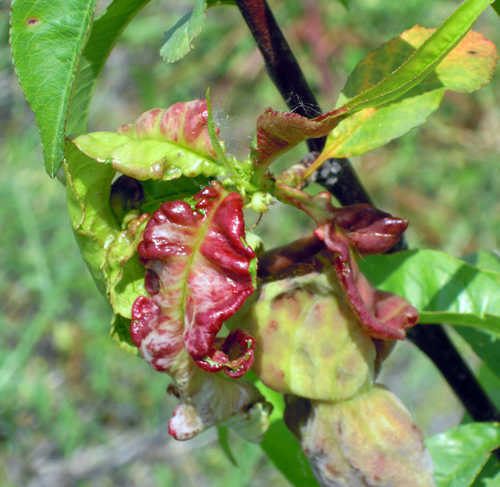Treat peach leaf curl now
Before or during bud swell is the time to treat peach leaf curl, a fungal disease that deforms leaves and then defoliates peach trees.
The warm weather forecast for this week and next, with highs forecast in the 70s and lows near 50, means that fruit trees will begin growth and grow rapidly. We may be several weeks ahead of normal by the next spring freeze which looks to be a week or more away. Growers need to get out their early disease control sprays.
|
For peach growers, the first spray of the year is to control “curl leaf” or peach leaf curl. Peach leaf curl is an important disease in Michigan. This disease can defoliate peach and nectarine trees. The fungus that causes peach leaf curl overwinters on the tree. Infections take place in the spring as the buds open. The fungus infects peach buds from bud swell to bud opening under wet conditions. Air temperatures between 50 to 70°F are ideal. Rain or dew moves spores into the opening buds, allowing the infection of young tissue. The disease requires about 10 to 11 hours of wetness for infection to occur. Prolonged cool wet periods during bud burst can result in severe infections. Early spring applications at or before bud break are effective in controlling this disease.
Effective controls include Bravo, Ziram, Carbamate and copper compounds. Most growers try to use copper early. If you believe an infection may have already occurred, you are better off using Bravo or Ziram rather than copper because these materials are more effective after infection. Later applications can reduce the severity of the disease. Copper compounds have the added benefit of providing some suppression of bacterial spot as well. (See Bill Shane’s article on copper compounds used on fruit). If you are going to use copper, be sure to use the rate of 4 to 8 pounds of metallic copper per acre. Some product labels may recommend less and some Michigan growers have been disappointed with lower rates. Peach growers in Berrien County, Mich., are already putting on their copper sprays now.
Once leaves are infected there is no effective fungicide treatment. The leaves are infected in the bud; once they have emerged they are no longer susceptible to infection. Infected leaves become crinkled, turning orange or red. The leaves become thick and powdery with spores as the fungus sporulates. Infected leaves eventually fall off. The tree will grow new leaves.
Peach leaf curl weakens the tree by removing leaves during early growth. This reduces energy the tree can absorb from the sun, weakening the tree, and reduces growth and fruit size. Heavy fruit thinning reduces stress on the tree and increases the likelihood of a marketable crop. Severely infected trees should receive an increased ration of nitrogen fertilizer. This will help the tree replace lost leaves and maintain vigor.



 Print
Print Email
Email



